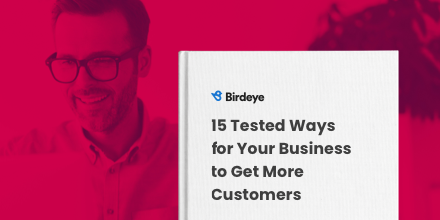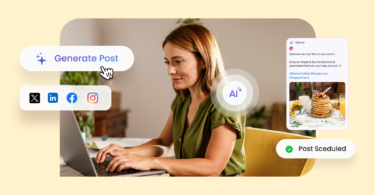Knowing your customers is an integral part of your business’s success. It helps you define brand strategies, choose product development tools, and find the proper channels for your sales team to engage with your customers.
But this knowledge does not come easy. That is why businesses invest in developing buyer personas before they get out there in the market. The right buyer personas can help you become an efficient and smart business in your industry.
This blog post uncovers everything you need to know about buyer personas and how to create the right one to help your business grow.
Table of contents
What is a buyer’s persona?
A buyer persona is a detailed depiction of your ideal customer as a fictional profile you build from market research. You may also know them as customer, audience, or marketing personas.
This profile describes an imaginary person who possesses the essential characteristics of your audience. This includes a psychological profile, demographic profile, values, and desires, to name a few.
Why do businesses need buyer personas?
Businesses need buyer personas to understand their customers and determine how to serve their needs better. Buyer personas help businesses to dwell into each ideal customer profile and identify attributes that uniquely identify them. This helps in designing better products and tailoring services accordingly.
By putting the customer front and center, you can translate your product’s features into benefits customers care about. Most importantly, buyer personas help you create an emotional connection with your audience. That emotional connection makes your marketing efforts more effective.
Benefits of buyer personas:
- Buyer personas help businesses understand customers and explore purchase motivations
- Buyer personas help businesses optimize sales strategies and drive results
- Buyer personas help businesses choose the proper marketing and advertising channels
- Buyer personas help develop better products with insight into customer requirements
Buyer persona help businesses understand customers and explore purchase motivations
You need buyer personas to understand better your target market, which usually has a heterogeneous composition of customers. By developing specific buyer personas, such as marketing personas, you stand to gain a deeper understanding of your customers.
It helps you explore behavior, motivations, pain points, social media usage, and other preferences.
Buyer personas help businesses optimize sales strategies and drive results
A buyer persona helps you zero in on the customer’s needs more than the business’s. Focusing on the customer is especially important during a marketing campaign.
With this information, your sales team can understand customers’ challenges and approach your target audience with appropriate solutions more convincingly. According to a study by Marketing Insider group, businesses that use buyer personas generate more leads and have shorter sales cycles.
Buyer personas help businesses choose the proper marketing and advertising channels
With detailed buyer personas, you can use your resources on channels that resonate better with potential customers. Different marketing channels, like social media and email marketing, work differently on your target audience, depending on their preferences.
In 2020, An RV Association wanted to run a campaign to attract vacationers and boost the sales of recreational vehicles. They developed buyer personas and determined that targeting one particular type of customer would help in generating sales. The information from the buyer persona helped them build a website, choose advertising channels, and achieve their sales target.
Buyer personas help develop better products with insight into customer requirements
Buyer personas are especially helpful before you invest significantly in product development and marketing strategies.
Understanding your customers lets you develop products & services that meet their needs and attract loyal customers. It’s also easy for you to identify gaps in the market, gather more information on desired features, and adapt your products accordingly.
Spotify discovered that reasons for different customer segments for buying and listening to music varied a lot only after they dived into the buyer persona research.
Birdeye – all-in-one platform
Automate Reviews, Ratings, Listings & Reputation Management with Birdeye.
How to create a buyer persona
Creating customer personas isn’t about describing a potential customer. It’s about developing a reflection of an existing customer in your target market. Creating a buyer persona aims to improve marketing, sales, and product development.
To create a thorough and effective buyer persona, businesses must follow these steps:
- Conduct audience research from various sources to gather data
- Talk to customers and experts via interviews and surveys
- Define elements of the buyer persona
- Dive into specifics
- Outline buyer personas
Conduct in-depth audience research from various sources to gather data
A detailed buyer persona starts with research. The more information you have, the better. Market research helps you get to know your customers and understand what they want and what problem they’re looking for you to solve.
Businesses can conduct audience research by
- Analyzing customer data from their website visitor information, social media ad metrics, PPC ad metrics, and so on.
- Studying their competitors, understanding who they serve, and what problems they solve for their customers.
- Analyze independent market studies, industry-wide reports, and third-party research data.
- Talking to their sales, pre-sales, and customer support teams to know more about customer needs, wants, and preferences.
- Analyze customer feedback channels such as reviews, marketing surveys, chatbot conversations, and social media conversations.
Talk to customers and experts via interviews and surveys
Reading reports is good, but sometimes, you must take a step ahead and talk directly to the people involved. Conducting interviews is a great way to collect essential information from your target audience.
Businesses can conduct one-on-one interviews with current customers, prospects, and a sample audience group from their target audience.
Conversations are a gateway to a wealth of information beyond primary demographic data. Talking to your customers helps you discover their pain points, motivations, and needs.
You can use survey tools such as Birdeye Surveys to conduct these interviews and get precise responses from your customer base.
Define elements of a buyer persona to fill out the template
Now that you’ve the data, it is time to derive critical insights and build a buyer persona template. To do so, you must begin by detailing the elements of your buyer persona.
These include:
- A fictional name for your persona
- A job title with a detailed description to help the business understand the motivation and needs of the customer
- Demographic details such as age, gender, location, and so on
- Goals of the person that may bring them closer to your business
- Challenges or pain points
- Values or beliefs that may bring them closer or farther from your business
- Fears
- Purchasing process
- Influencing sources
- Active communication channels
- Other important preferences
While you can easily define the essential elements of the buyer persona, it is vital to dwell deeper on some that help you differentiate each customer profile from the other.
Download our buyer personas template to get started right away!
Dive into specifics to gain insights into customer preferences
Once you create a buyer persona template, determine your customers’ goals and objectives. You can derive information from studying the challenges your target audience is facing and looking to solve.
Add as much defining and specific information as possible to the buyer persona. Focus on information that can help you understand:
- Who influences customers in their purchase decisions?
- How does the customer discover a product or service?
- What needs do they want to address with your product or service?
- Why would they choose you or your competitor?
- How does the product fit as a solution for the customer?
A link between the challenges they’re facing and how your product/service IS important to connect with customers. Including this information in each buyer persona helps the sales and marketing teams craft the right messaging for that section of the target audience while promoting the business.
Understanding these details will help convert potential customers into active customers and build long-term relationships.
Outline buyer personas
Now that you have all the necessary information, it’s time to create a detailed outline of your buyer personas.
Each persona should include demographics, job roles, challenges, goals, and preferred communication methods. It could also be helpful to add personal anecdotes to add more authenticity to the persona.
After creating the personas, compare them to your collected data and feedback. Make any adjustments as necessary based on the data and feedback from your sales, marketing, and development teams.
Do not treat the personas as rigid, and regularly update them as your business evolves.
Examples of buyer personas
Developing a buyer persona may feel like a daunting task but the Birdeye buyer persona template makes it easier. The template helps you break down research data and categorize it accordingly.
Here are some buyer persona examples to help guide you when creating some using our template for your business:
Rachel – buyer persona for a multi-location retail store
Rachel is a 32-year-old sales manager who lives in a suburban area with easy access to the retail store. She earns $70,000 annually. Being a busy professional, she values convenience and quality.
Rachel’s goal is to find high-quality products within her budget. She would also like to enjoy a stress-free shopping experience. Some major struggles for Rachel are:
- managing finances while sticking to a budget,
- balancing her work, family, and shopping time, and
- the overwhelming choices retail offers.
She enjoys shopping on weekends and considers online and in-store shopping valuable. Payment security during online purchases is vital as she is fearful of privacy issues.
Rachel relies on online reviews to make an informed shopping decision. She also enjoys spending time on Instagram and Facebook to discover new products.
Henry – buyer persona for a dental clinic
Henry is a 45-year-old Financial Analyst who lives in an urban area within a 10-mile radius of the dental clinic. Annually, he makes $200,000. He is health-conscious and values a confident smile.
Currently, he is struggling to maintain oral hygiene due to conflicting schedules with dentists and is unable to book an appointment due to its working hours.
- He prioritizes maintaining his oral hygiene for health and professional reasons.
- He aims to find a dental clinic that offers convenient appointment scheduling and promptly addresses any dental issues.
- He struggles with a demanding job that leaves him with limited free time and dental anxiety due to his past experiences.
When looking for dental services, Henry considered the reputation of the clinic, flexible appointment slots, and transparent pricing information. He prefers email for appointment reminders and follow-up care instructions. He reads website and online reviews when researching a clinic’s reputation and customer service.
Scarlet – buyer persona for an Insurance company
Scarlet is a 28-year-old Elementary school teacher living in a suburban area about 20 miles within the radius of the insurance company’s office. She earns $45,000 annually. As a relatively young person, she is in the process of building a stable life and wants to have a secure financial future.
- She’s concerned about unexpected events that could disrupt her plans.
- She aims to secure insurance coverage that offers protection and peace of mind and aligns with her future home ownership goals.
- She struggles with her budget since her income is limited, and she lacks familiarity with insurance terminology.
When considering an insurance firm, she prioritizes clear insurance options and terms, affordable premiums, and the ability to customize coverage to suit her needs. She prefers direct email communication when inquiring about policies and receiving updates.
She relies on online resources to research insurance options and learn more about coverage details.
Coal – buyer persona for a real estate business
32-year-old marketing manager, Coal, makes $80,000 a year and is looking for a new home. He values style, convenience, and a sense of community.
Coal wants to find a modern home in a dynamic neighborhood with many shopping, dining, and entertainment options. He also hopes to invest in real estate to fund his future. Coal needs help finding time to visit properties due to his demanding job. He wants a property within his budget while still checking off his must-haves.
Coal places a high value on a short work commute. Recreational activities, modern design, and competitive pricing also top his list.
He prefers emails for property listings and scheduling viewings. He uses social media platforms for inspiration.
Dana – buyer persona for a Storage facility with 10+ locations
Dana is a 45-year-old small business owner living in a suburban area. She earns $70,000 a year. Being a busy entrepreneur, Dana needs flexible storage solutions for her business inventory.
Dana wants a reliable partner to manage her storage needs at an affordable price. She also wants a convenient and secure storage solution for her inventory.
She worries about security, her inventory remaining organized, and the possible damage to goods. Location, security measures, and leasing options top her list.
She prefers phone calls. She also relies on Google Maps and navigation tools to find the nearest options.
FAQs about buyer personas
You build buyer personas by conducting audience research, understanding motives, and gathering reliable details.
The key parts of a buyer persona are demographics, goals, values, and fears.
The four types of buyer personas include primary, secondary, negative, and customer persona.
Understand your audience with Birdeye
Creating buyer personas helps you understand your audience. Following the steps that help you create a comprehensive persona will positively impact your business growth.
Birdeye helps businesses gain insights from customer interactions and feedback channels to craft the most effective buyer personas. Contact us today to know more!

Originally published









